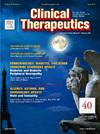阿莫西林大剂量静脉间断阿莫西林血药浓度:超越数字。Max-Amox研究。
IF 3.6
4区 医学
Q2 PHARMACOLOGY & PHARMACY
引用次数: 0
摘要
目的:建议使用大剂量阿莫西林治疗严重感染,如心内膜炎。阿莫西林会产生剂量依赖性毒性,尤其是晶体肾病。监测阿莫西林血浆谷浓度(ATPC)可避免中毒。然而,对 ATPC 检测在常规医疗实践中的相关性研究仍然很少:我们在法国一家大学医院对接受大剂量间断静脉注射阿莫西林治疗的成人进行了一项前瞻性临床试验。主要结果是治疗第一周三天内 ATPC 的分布情况。此外,还对尿液进行了阿莫西林结晶尿(AC)、pH 值和密度检测:共纳入 70 名患者。总体类内相关性(ICC)为 0.35 IC95% [0.21; 0.53],配对一致性如下:D1-D4 (n= 55) 0.23 IC95% [-0.02; 0.47],D1-D7 (n= 47) 0.41 IC95% [0.19; 0.63],D4-D7 (n= 50) 0.17 IC95% [-0.10; 0.43]。个体间变异性也很显著,D1、D4 和 D7 的变异系数分别为 0.87、1.20 和 1.35。32 名患者(47.8%)发生了 AC。当 pH 值低于或等于 6 时,AC 风险增加(P = 0.002)。有 AC 和/或急性肾损伤的患者的 ATPC 较高:ATPC的变异性很高,不能将ATPC视为调整阿莫西林剂量的唯一监测工具。高 ATPC、低尿 pH 值和存在急性肾损伤可提醒医生注意潜在的先天性影响,从而决定为患者补充水分、碱化尿液并减少阿莫西林的用量。本文章由计算机程序翻译,如有差异,请以英文原文为准。

Amoxicillin Blood Concentration in High-Dose Intravenous Discontinuous Amoxicillin: Look Beyond Numbers. Max-Amox Study
Purpose
High doses of amoxicillin are recommended to treat severe infections such as endocarditis. Amoxicillin causes dose-dependent toxicities, in particular crystal nephropathy. Toxicity could be avoided by monitoring of amoxicillin trough plasma concentrations (ATPC). However, the relevance of ATPC testing in routine medical practice remains poorly studied.
Methods
We conducted a prospective clinical trial in adults treated with high doses of discontinuous intravenous amoxicillin in a French university hospital. The primary outcome was the distribution of ATPCs over three days during the first week of treatment. Urine tests for amoxicillin crystalluria (AC), pH, and density were also performed.
Findings
Seventy patients were included. Overall intra-class correlation (ICC) was 0.35 IC95% [0.21; 0.53] with the following pairwise concordances: D1-D4 (n= 55) 0.23 IC95% [-0.02; 0.47], D1-D7 (n= 47) 0.41 IC95% [0.19; 0.63], and D4-D7 (n= 50) 0.17 IC95% [-0.10; 0.43]. Inter-individual variability was also significant, with coefficients of variation being 0.87 at D1, 1.20 at D4, and 1.35 at D7. AC occurred in 32 patients (47.8%). Risk of AC increased when pH was below or equal to 6 (P = 0.002). ATPCs were higher in patients with AC and/or acute kidney injury.
Implications
Variability in ATPC was high and ATPC cannot be considered as the only monitoring tool to adjust amoxicillin dosage. High ATPC, low urinary pH, and presence of AC can alert physicians to a potential iatrogenic effect and lead to the decision to hydrate the patient, alkalinize urine and decrease the dosage of amoxicillin.
求助全文
通过发布文献求助,成功后即可免费获取论文全文。
去求助
来源期刊

Clinical therapeutics
医学-药学
CiteScore
6.00
自引率
3.10%
发文量
154
审稿时长
9 weeks
期刊介绍:
Clinical Therapeutics provides peer-reviewed, rapid publication of recent developments in drug and other therapies as well as in diagnostics, pharmacoeconomics, health policy, treatment outcomes, and innovations in drug and biologics research. In addition Clinical Therapeutics features updates on specific topics collated by expert Topic Editors. Clinical Therapeutics is read by a large international audience of scientists and clinicians in a variety of research, academic, and clinical practice settings. Articles are indexed by all major biomedical abstracting databases.
 求助内容:
求助内容: 应助结果提醒方式:
应助结果提醒方式:


